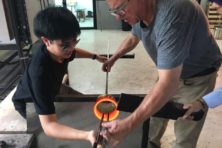The Art of Introduction: It pays for new artists to know how to introduce themselves to a gallery
- Share
- Tweet
- Pin
- Share

When Claudia Scimeca took over ARTicipation a year and a half ago, she planned to curate art that she found interesting from Midwestern artists and pursue them to show in the gallery.
But as more and more artists discovered the Sturgeon Bay gallery, and artists began asking how they could get their work displayed, she began directing them to the submission form on the ARTicipation website, although she still invites artists to stop in and chat.
“We encourage artists to visit the gallery during our main hours,” she said. “Visiting allows you to see if your work would be a good fit. It also gives you a chance to introduce yourself and ask any questions you may have.”
Her decisions on whether to invite an artist to exhibit are personal.
“I am not doing it for the audience, I pick whatever speaks to me,” she said. “Although I do abstract work, I don’t show just abstract art. I want to make the gallery diverse and interesting.”
She also wants to give new artists a chance who might not make it into the county’s longer-established galleries.
“I feel like it’s a win-win-win for me, the artist and the audience,” she said.
But she also knows she has to contain her enthusiasm.
“I like art so much, but I am very mindful of not getting too cluttered,” she said.

Door County’s big four galleries – Edgewood Orchard Galleries in Fish Creek; Fine Line Designs in Ephraim; Plum Bottom Gallery at four locations in Door County; and Woodwalk Gallery in Egg Harbor – have policies and website submission forms for artists who would like to join. Three of those have dates within which they will accept submissions for consideration, and a couple of those are outside the height of the busy season. Jillaine Seefeldt, then at Woodwalk told me a few years ago when she was at Woodwalk of an artist who came in on a busy July day and demanded that she look at her work right then.
That’s not uncommon for galleries, and yet it is common that galleries can’t devote time to new artists at the height of their busy seasons. Edgewood Orchard Galleries in Fish Creek explains this on its artist submission page on its website.
“We are open seven days a week from May through October, and during this time we devote our full energy to the artists that we currently represent,” its website reads. “For this reason, we hope that you will understand that we are unable to look at new work during the gallery season, but look forward to it after we close.”
It asks artists to submit images between Sept. 1 and Nov. 15, preferably on a CD, with a title, medium, dimensions, date the piece was completed and the retail price of the work.
The instructions are polite, but firm, as it has to be: the gallery receives 150 to 200 inquiries a year from artists who would like to exhibit their work, but adds only eight to 10 new artists each year.
“It is also helpful to us if you enclose your resume and any other supporting materials that help us get to know you and your artwork better,” its submission page says.
Beyond When to Submit: More Advice on How
The crush of artists looking for a place to display their work has reached smaller galleries too – including those operated by artists who understand what it is like to seek gallery representation.
Ginni Cappaert, a painter who runs Cappaert Contemporary in Egg Harbor, exhibits at Edgewood and shows at galleries in Santa Fe and Michigan. She said even her small gallery gets 10 to 20 new-artists requests a year. She has created a submission form on her website for artists who have found her on social media or visited her gallery.
“My number-one recommendation, if you are thinking of a gallery, is to see if your work fits in with what that gallery exhibits,” she said.

Cappaert said a good way for artists to gauge that fit is to look at the style and price range of the work the gallery shows.
“And before you make a phone call or send an email, go to their website and see their submission process,” she said.
Some galleries, for example, won’t take artists who are outside their driving area because they don’t want to hassle with shipping and they don’t want to handle boxes, Cappaert said.
“It’s one more job the gallery has to do,” she said.
What she’s looking for in new artists is an indication of their seriousness. An artist’s history of showing their art tells her that.
“I want to know that an artist can hand over 20 paintings every spring,” she said.
Quality is always important.
“When a gallery is looking at work, they can tell if the artist is a beginner and needs more years,” she said.
The solution may be classes and more training, either in-person or online.
“My favorite model is just do the work, make it your full-time job, even if you already have a full-time job,” she said. “We all are working three full-time jobs in the art world.”





